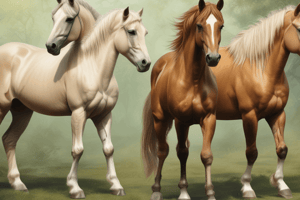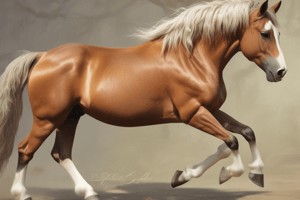Podcast
Questions and Answers
Which of the following is a foundation sire for the Tennessee walking horse?
Which of the following is a foundation sire for the Tennessee walking horse?
- Justin Morgan
- Godolphin Arabian
- Allen F-1 (correct)
- Darley Arabian
Which color description best fits a bay horse?
Which color description best fits a bay horse?
- Light reddish/yellow color
- Reddish, brown or dark brown with black points (correct)
- Brown with no black points
- Golden color with a white mane and tail
What distinguishes a true black horse from other black horses?
What distinguishes a true black horse from other black horses?
- Liver chestnut coloring
- Having a black coat with black skin (correct)
- Having a black coat with white skin
- No red highlights in its coat
What is the main characteristic of a palomino horse?
What is the main characteristic of a palomino horse?
Which stallion is not one of the three foundation stallions of the thoroughbred breed?
Which stallion is not one of the three foundation stallions of the thoroughbred breed?
What color of horse is described as having no black points and being primarily red?
What color of horse is described as having no black points and being primarily red?
Which of the following is a color breed that developed with strict color requirements?
Which of the following is a color breed that developed with strict color requirements?
What is the primary distinction between buckskin and dun horses?
What is the primary distinction between buckskin and dun horses?
What unique feature characterizes the Leopard Appaloosa?
What unique feature characterizes the Leopard Appaloosa?
How is the height of a horse measured?
How is the height of a horse measured?
What is the maximum height and weight of light horses?
What is the maximum height and weight of light horses?
Which breed is known for being America's first breed of light horse?
Which breed is known for being America's first breed of light horse?
What distinguishes the draft horse from other horse classifications?
What distinguishes the draft horse from other horse classifications?
What is a unique trait of the Arabian horse?
What is a unique trait of the Arabian horse?
During what age range does the Lipizzan horse typically change color?
During what age range does the Lipizzan horse typically change color?
What characteristic is associated with American Quarter Horses?
What characteristic is associated with American Quarter Horses?
What gene is responsible for the cream color in horses?
What gene is responsible for the cream color in horses?
What distinguishes a blue roan horse?
What distinguishes a blue roan horse?
Which of the following describes a dapple gray horse?
Which of the following describes a dapple gray horse?
What is the main difference between a Paint horse and a Pinto?
What is the main difference between a Paint horse and a Pinto?
How does roaning on a horse typically occur?
How does roaning on a horse typically occur?
Which coat pattern should an Overo horse NOT exhibit?
Which coat pattern should an Overo horse NOT exhibit?
What characterizes a Grullo horse?
What characterizes a Grullo horse?
What are common features of an Appaloosa horse?
What are common features of an Appaloosa horse?
Flashcards are hidden until you start studying
Study Notes
Foundation Sire
- Worldwide about 300 breeds of horses exist
- Many breeds of horses started with a foundation sire and for those breeds all registered foals must be able to trace their ancestry back to these stallions
- 3 foundation stallions make up the thoroughbred
- Darley Arabian
- Byerly Turk
- Godolphin Arabian
- 3 foundation stallions make up the thoroughbred
- Justin Morgan is the foundation sire for the Morgan breed
- Allen F-1 A Morgan Stallion is the foundation sire for the Tennessee walking horse
- Morgan stallions also contributed to the development of the standard bred, quarter horse, American Albino, and Palomino
Colored Breeds
- Certain breeds were developed with color requirements
- For some breeds the only registry requirement is color
- These are some examples:
- Palomino - first color breed
- Appaloosas
- Albinos
- Paints
- Pintos
- Buckskins
- Whites
- Cremes
- Spotteds
Bay
- Is any reddish, brown or dark brown color with black points
- A very dark bay can be confused with black
- Look for red undertones in the body and black points
Black
- Has a black coat and black points
- Most black horses have white skin
- A black with black skin is called a true black
- Sometimes the sun will burn reddish highlights into a black coat
Brown
- A brown horse is brown with no black points
- Color is more like chocolate, not reddish
- Can be very dark, sometimes mistaking them for a black
Chestnut
- Color is basically red
- Can vary from light to dark
- No black points
- Liver chestnut is a very dark chestnut
- Liver chestnut could be confused for a brown, if not for the reddish mane and tail
Sorrel
- A light reddish/yellow color
- Mane and tail can be blonde or same as the body
- Europe: light chestnut
- America: sorrel
Palomino
- Golden color with a white mane and tail
- Considered a color breed, meaning they can be registered with the Palomino breed association if they meet all requirements
Buckskin or Dun
- Terms often used interchangeably
- Buckskin is a yellowish gray with dark points
- Dun tends to have more red in the coat
- Dun vs.Bay?Duns have a dorsal stripe sometimes accompanied by a shoulder stripe or zebra stripes on the legs
Cream
- Comes from the 'cream' gene
- Cream gene dilutes the base colors chestnut, bay and black
- When it dilutes palomino or buckskin it gets even lighter
Gray
- A truly white horse is very rare
- Most white horses are really a light gray
- Gray horses are often darker at birth and become lighter and lighter with age
- Gray coat is made up of white hairs and hairs with color in them
- Gray can be light or dark
Dapple Gray
- Gray with distinct white marks splattered throughout the coat
- When a dapple gray has black points it can be called a blue roan as well
Grullo
- Color comes from a Dun overlay on a black
- Hairs are mousy colored
- Have dark points
- Can have a dorsal stripe, zebra stripes (bars) on legs or a mask (dark face)
Blue Roan
- Dark base color with white hairs mixed in
- Has dark points and black undertones
Red Roan
- Has a chestnut base color with white hairs mixed in and red or dark red/brown points
- Can have red or blonde mane and tail
Appaloosa
- A spotted or speckled horse often with roaning
- Both a color and a breed of horse
- Have spotted coats, mottled skin, white sclera and striped hooves
Paint vs.Pinto
- Terms both refer to large spotted patterns on a horse.The difference is breed.
- Paint horse can only be Quarter Horse or Thoroughbred lineage
- Pinto is used to describe a spotted horse of any breed
Roan and Dapples
- Roan or roaning on a horse is sometimes called varnish
- Occurs when white hairs are mixed in with the base coat color
- Dapples are lighter colored round spots on the coat
- Some dapples are seasonal, appearing only on a summer coat
Tabiano vs.Overo
- Refer to the spot patterns of Paint horses
- Tabiano has white spots that cross over the top line
- With the Overo pattern, the white markings never cross over the top of the back, neck or rump
- Overo is used for Paints that are not clearly Tabiano or Overo.
Appaloosa Pattern
- Blanket Appaloosa has a distinct white marking spread across the rump
- May or may not contain spots
- Leopard Appaloosa has distinct leopard like spots over a white coat
Hands
- Horses are also classified according to size, weight, build and use
- Common measurement for horses
- Hand - is equal to four inches
- Height of the horse is measured from the top of the withers to the ground
- E.g., a horse that is 15 hands is 60 inches or 5 feet at the withers
Light Horses
- 14.2 to 17.2 hands high and weigh 900 to 1400 lbs
- Used for riding, driving, showing, racing, or farm and ranch work.
- More agile and can travel at greater speed than draft horses
Draft Horses
- 14.2 to 17.2 hands high and weigh 1400 lbs or more
- Used for heavy work and for pulling loads
Ponnies
- Ponies stand under 14.2 hands and weigh 500 to 900 pounds
- Generally draft, heavy harness, or saddle type
Appaloosa
- Well-known for speed
- Used by the Nez Perce Indians as war horses
- Originated from Spanish horses left behind by explorers
Arabian
- Originated from Bedouin desert
- Known for strength and stamina
- Small muzzle
- High tail setting
- Short back
Lipizzan
- Developed in Spain
- Born brown or black in color
- Changes to white or gray at about 6-10 years of age
- Famous as dressage performers
- Dressage - the art of riding and training a horse in a manner that develops obedience, flexibility, and balance
Morgan
- Developed in the United States
- America's first breed of light horse
- Descended from one horse, Justin Morgan
Mustang
- Feral horses of the Western United States, descended from horses brought to the Americas by the Spanish
- Sure-footed with good endurance
- Ability to negotiate difficult or rough terrain safely
American Quarter Horses
- Developed in the US as a race horse
- Named for their fast times in the 1/4 mile
- Known for speed, strength & intelligence
- Most popular horse breed in the world
Saddlebred
- Developed in the US
- Ave. 15 to 16 hands (60 to 64 in)
- Weigh between 1,000 and 1,200 lbs (450 and 540 kg)
- Well-shaped heads with a straight profile, long, slim, arched necks, well-defined withers, sloping shoulders, correct leg conformation, and strong level backs with well-sprung ribs
- Croup is level with a high-carried tail.
Studying That Suits You
Use AI to generate personalized quizzes and flashcards to suit your learning preferences.




